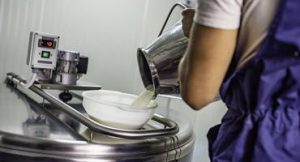
The USDA Origin of Livestock rule outlines how organic dairy farms can source the cows they use to produce milk. Generally, organic dairy farms can only transition cows from conventional care — using antibiotics and cheaper, non-organic feed — to the more expensive organic care once in that farm’s lifetime.
Under the old version of the rule however, Vermont Organic Farmers certification director Nicole Dehne says some out-of-state certifiers could allow operations to continuously raise cows using conventional care, then switching to organic care when the cows were a year old.
“So they would basically get, you know, a year — maybe a bit more — of the cost savings and managing those young stock,” Dehne said.
That made it harder for Vermont organic dairy farms to stay competitive, according to Corse Farm Dairy co-owner Abbie Corse. She and her family currently milk 54 cows in Whitingham.
“It drives the [milk] price down for … those of us who are already smaller, and at a disadvantage when competing in economies of scale,” Corse said. “It flooded the market with this cheaper, quote-unquote, you know, ‘organic milk,’ that’s just, it’s not an equivalent thing, because the animals aren’t being raised organically.”
Corse says in order for farms like hers to remain viable, any operation that’s producing milk labeled as “organic” in the grocery store needs to use the same holistic – and also, more expensive – management practices.
“We need it to be easy for consumers to trust and understand what that label means when they buy it both from an animal care perspective, a land care perspective and an environmental perspective,” she said.
In what Corse called a “really important first step,” the USDA published a new version of the Origin of Livestock rule on Tuesday. Organic dairy operations can now only transition cows from conventional to organic practices once in the operation’s lifetime, and they cannot add transitioned cows from another operation. Any cows an organic dairy farm raises or buys have to be managed organically starting even before they’re born — the breeding cow has to be managed organically starting in the final three months before birth.

Nicole Dehne with Vermont Organic Farmers called this change a “win.”
“This is a regulation change that we’ve been advocating for for many years,” she said. “And this does level the playing field for organic dairy producers all across the country. So that is really exciting.”
The Real Organic Project, a farmer-led movement that began in Vermont in response to the lack of enforcement of USDA organic standards, tweeted to “break out the champagne” (and to “make sure it’s organic bubbles”) after hearing the news.
In the words of our co-director of certification, Ariel: "break out the champagne, this was a long time coming" (just make sure it's organic bubbles!). Now to address the dozens of other recommendations still stalled… #onward #savethesoil #saveorganic https://t.co/gcbi7HhanH
— Real Organic Project (@realorganicproj) March 30, 2022
Sen. Patrick Leahy also applauded the move. He thanked the USDA in a written statement, adding: “We must remain vigilant in protecting organic standards. This will help ensure that large producers are not abusing a loophole to give themselves an unfair advantage.”
Dehne noted that the USDA’s enforcement of its pasture rule could improve. She questions, for instance, whether the mega-sized organic dairies in hot, dry parts of the country have enough grass to have their cows get 30% of their diet from pasture, as national standards mandate.
For now, though, Dehne says the federal rule change “should be celebrated.” It comes on the heels of another win for Vermont’s organic dairy industry, when Organic Valley offered letters of intent to farmers dropped by Horizon Organic.























